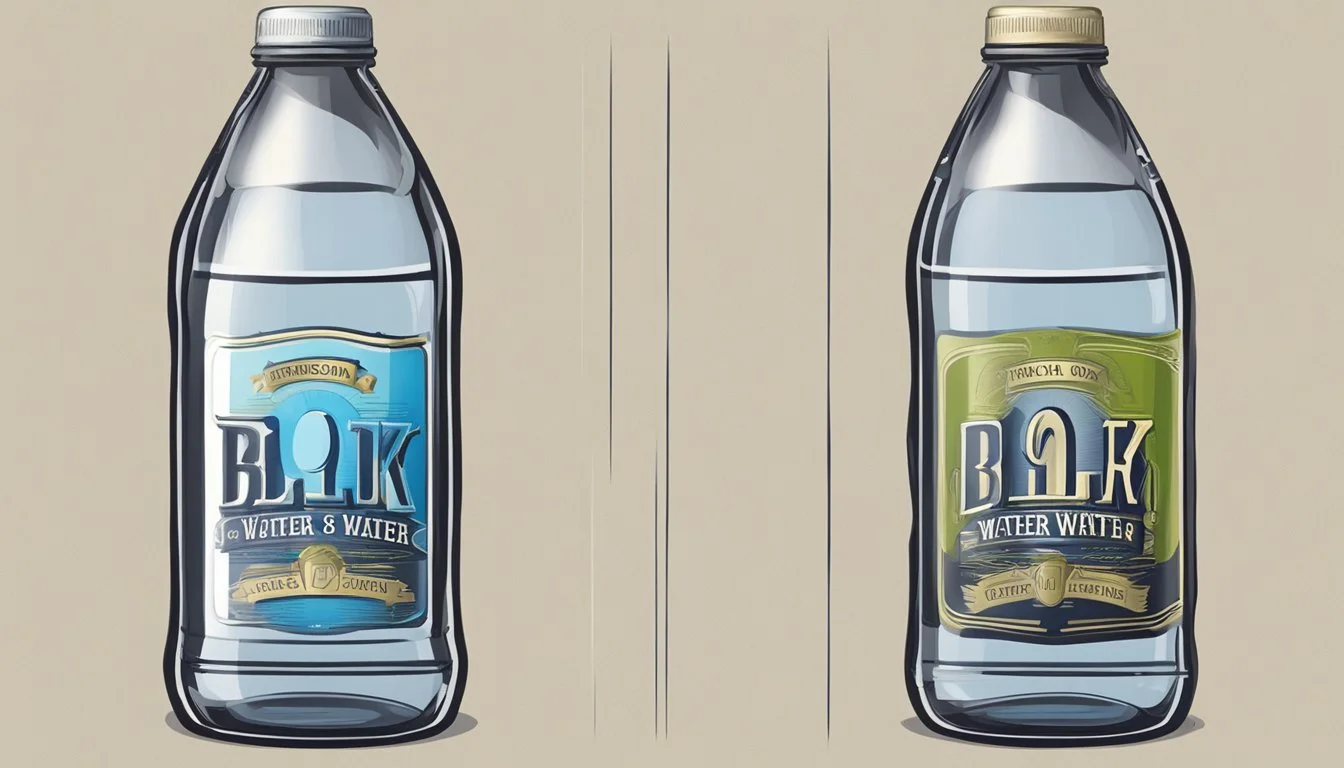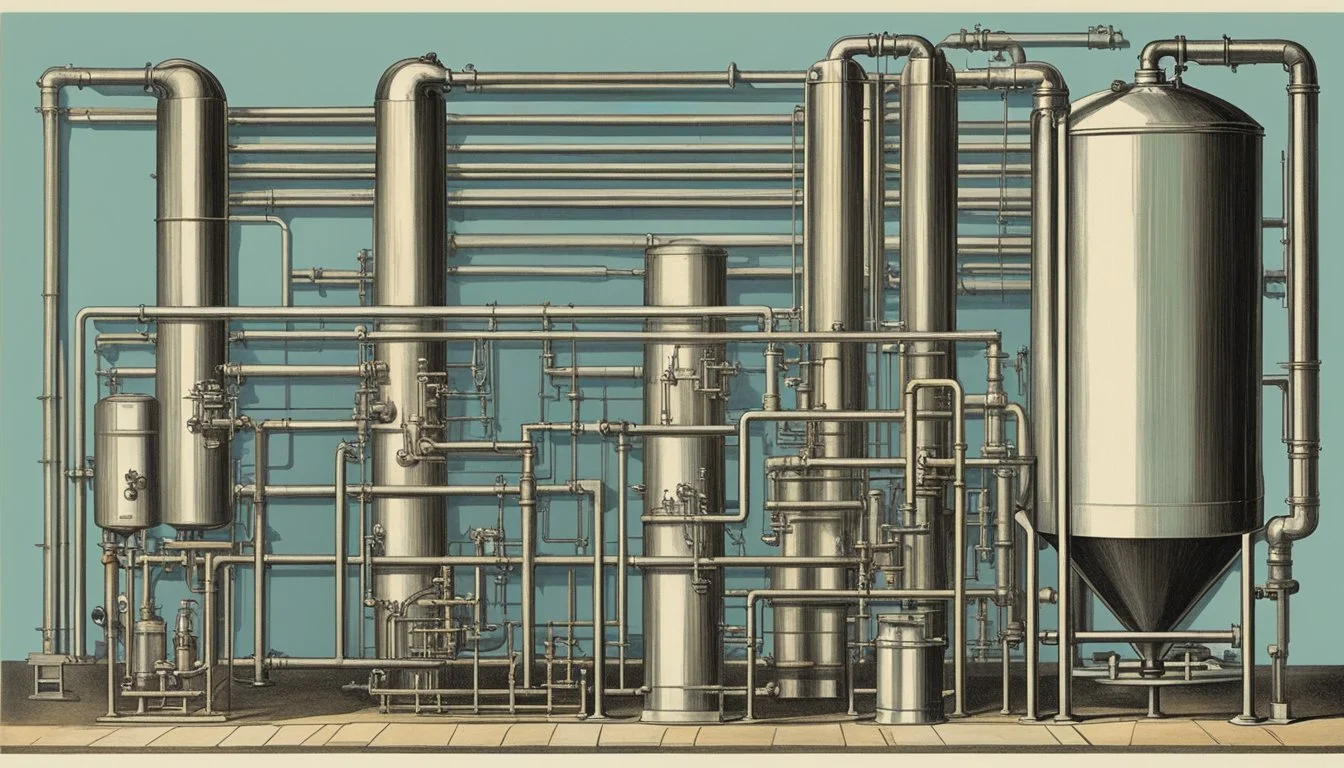1907water vs. Blk
Comparing Bottled Water Brands for Quality
When it comes to premium bottled water options, two brands that often stand out are 1907water and blk. Water. Each offers unique characteristics that cater to different preferences. 1907water, sourced from the ancient aquifers of New Zealand, promises a crisp, clean taste from naturally low-mineral sources. On the other hand, blk. Water’s striking black appearance comes from its infusion with fulvic trace minerals, which are touted for their potential health benefits.
For those prioritizing taste and purity, 1907water emerges as the preferable choice for its exceptionally fresh and unaltered flavor profile. In contrast, blk. Water appeals to consumers intrigued by its mineral content and distinctive look. It's a visual and sensory experience that breaks the mold of traditional hydration products.
Price considerations also play a role. 1907water typically falls into the premium price category, reflecting its artisanal sourcing, while blk. Water carries a significant markup due to its unique composition and branding. Understanding these differences helps consumers make informed decisions based on their individual hydration preferences and health priorities.
Overview of Bottled Water Industry
The bottled water industry has seen significant growth over the past few decades, driven by increasing health awareness and demand for convenience. Major players in the market are continuously innovating to meet consumer needs and preferences.
Rise of Bottled Water Popularity
The bottled water industry has experienced a substantial rise in popularity. This growth can be attributed to health concerns around drinking water contamination and a shift towards healthier beverage choices. Bottled water sales in the U.S. reached 15.9 billion gallons in 2022, reflecting its widespread acceptance as a safe and convenient alternative to tap water.
Consumer preferences are also influenced by the convenience of purchasing bottled water from grocery stores and other retail points. The sanitary packaging further reassures consumers who are worried about health risks, particularly gastrointestinal disorders from tainted water. As a result, the demand keeps growing across various regions.
Key Players in the Market
Several key players dominate the bottled water market, both in the U.S. and globally. Among the notable brands are Aquafina, Dasani, and Nestlé Pure Life, which offer a variety of products catering to different consumer tastes and preferences.
These companies invest heavily in marketing and innovation, striving to introduce new variants such as flavored, alkaline, and mineral-enriched water. The global bottled water market, valued at approximately USD 303.95 billion in 2022, involves intense competition among brands aiming to expand their market share through strategic initiatives and partnerships.
The U.S. bottled water market alone was valued at USD 44.6 billion in 2023 and is expected to grow further with a CAGR of 5.8% from 2024 to 2030. This growth highlights the robust consumer demand and potential for continued industry expansion.
Understanding Water Quality and Sources
Water quality and sources significantly impact the choice between bottled water brands. Exploring where the water originates, how it compares to tap water, and what indicators measure quality will help you make an informed decision.
Sources of Bottled Water
Bottled water comes from various sources, including natural springs, mountain springs, and groundwater. Brands often label their bottles to indicate the water source. For instance, some use natural spring water, which is collected directly from a spring, while others may use municipal water, which is essentially tap water subjected to further filtration.
Consuming water from these natural sources can offer a sense of purity and a distinct taste profile. Brands like 1907water might highlight their source as pristine mountain springs, suggesting a higher quality derived from natural filtration processes.
Tap Water vs Bottled Water
Tap water is primarily sourced from municipal water systems, which draw from rivers, lakes, or groundwater. This water undergoes treatment to meet safety standards before reaching households. In contrast, some bottled water brands also use municipal sources but may further purify it.
Drinking water from the tap is generally safe, yet people often perceive bottled water as cleaner due to branding and lack of contaminants. However, this isn't always true and depends on the brand's filtration processes and source.
Evaluating Water Quality Indicators
Water quality indicators determine the safety and taste of drinking water. Key indicators include pH levels, mineral content, and the absence of contaminants.
For example, 1907water might emphasize its neutral pH and low TDS (Total Dissolved Solids) for a cleaner taste, while Blk might focus on its mineral-infused, naturally alkaline water due to its sourcing from mountain springs.
PFAS and other toxic chemicals are a concern in both bottled and tap water. Brands undergo rigorous testing to adhere to safety standards, ensuring their drinking water is free from harmful substances. The difference in sources and purification methods often influences these quality measures.
Utilizing these indicators, consumers can better assess which drinking water meets their standards for quality and safety.
1907water vs Blk: Brand Profiles
Exploring the characteristics of both 1907water and Blk water provides insight into what sets these bottled water brands apart from the crowded market. We'll look into their origins, unique attributes, sources, and positioning in the competitive landscape.
1907water: Brand Overview
1907water originates from an ancient artesian source in New Zealand, providing a naturally alkaline water with a pH level of 8.0. Sourced from a deep aquifer, this water is known for its purity and mineral-rich composition. 1907water offers a premium hydration experience, positioning itself as an eco-friendly brand with a focus on sustainability. The packaging is sleek and environmentally conscious, which appeals to consumers who prioritize both health and the environment.
Key Attributes:
Source: Ancient artesian aquifer in New Zealand
pH Level: 8.0 (alkaline)
Mineral Content: High in natural minerals
Packaging: Eco-friendly and sustainable
Blk: Brand Overview
Blk water stands out due to its distinctive deep black color resulting from its infusion with fulvic acid, which is claimed to offer various health benefits. It positions itself as a functional beverage beyond basic hydration, aiming to provide trace minerals and electrolytes. Blk's marketing highlights its uniqueness and the idea of drinking a "premium lifestyle" product. The product is sold at a premium price, reflecting its distinctive branding and targeted demographic.
Key Attributes:
Color: Black due to fulvic acid
Health Claims: Infused with trace minerals and electrolytes
Market Position: High-end lifestyle and wellness product
Pricing: Premium-priced compared to standard bottled water brands
Health and Hydration Analysis
In comparing 1907water with blk. water, it is crucial to examine their respective impacts on health and hydration. The differences in nutritional benefits and mineral content significantly shape their overall value.
Nutritional Benefits of Hydration
Hydration is vital for maintaining the body's fluid balance. Both 1907water and blk. water offer unique benefits.
1907water is sourced from New Zealand and is known for its natural purity. It provides essential hydration without added chemicals. This is beneficial for daily hydration needs, promoting overall health and vitality.
Blk. water stands out for its inclusion of fulvic trace minerals. These minerals can aid in nutrient absorption and detoxification. Consuming blk. water might offer additional benefits such as improved gut health and enhanced sleep quality due to its alkaline nature.
Health Implications of Mineral Content
The mineral content in bottled water affects both health and hydration efficiency.
1907water contains a balanced mix of electrolytes like calcium and magnesium. These minerals support muscle function, bone health, and electrolyte balance. Its naturally occurring mineral composition aligns well with promoting daily health and hydration needs.
Blk. water is enriched with fulvic trace minerals and has a higher pH level, making it alkaline. The higher pH can neutralize acidity in the body, potentially benefiting those with acid reflux. Additionally, the fulvic minerals contribute to detoxification and nutrient absorption. However, it's essential to note that blk. water's unique composition results in a darker appearance, which some might find off-putting.
In summary, both 1907water and blk. water offer distinct health and hydration benefits. Selecting between them depends on personal health goals and preferences for mineral content and hydration efficiency.
Taste and Water Preference
When evaluating 1907Water and Blk, taste and water preference play crucial roles. Differences in origin, mineral content, and additives can significantly impact the overall taste.
Factors Influencing Bottled Water Taste
Several factors influence how bottled water tastes. Mineral content is a key element—1907Water, sourced from New Zealand, is noted for its balanced mineral composition, giving it a clean and smooth taste. Blk Water, on the other hand, contains fulvic minerals, which can impart a subtle earthy flavor.
Another important factor is chlorine. Bottled water typically lacks the chlorine found in tap water, which can make the water taste purer. Origin also plays a role; water from different sources can have varying taste profiles based on local geological features.
Subtle flavors can also result from natural filtering processes. Waters from pristine sources often boast distinctive tastes, differentiating them from those that undergo extensive commercial processing.
Consumer Taste Test Results
Consumer taste tests provide insights into water preferences. A blind taste test revealed distinct preferences for both 1907Water and Blk. 1907Water often rates highly for its crisp, clean taste with a notable absence of aftertaste. Many consumers appreciate its refreshing qualities, highlighting its natural purity.
Blk Water, known for its unique appearance due to added fulvic minerals, delivers a slightly different experience. Reviews often describe it as having a neutral to mildly earthy flavor. Some consumers find this intriguing, while others prefer more traditional tastes.
In terms of popularity, 1907Water generally outperforms in taste tests, often praised for its smooth mouthfeel and lack of strong mineral overtones. Blk Water, with its distinctive flavor and appearance, appeals to niche markets and those seeking novelty in their hydration choices.
Environmental and Safety Considerations
Selecting the best bottled water involves understanding the environmental impacts and safety measures that both 1907water and Blk employ. This includes the type of materials used, adherence to regulations, and the introduction of eco-friendly practices.
Bottled Water and Environmental Impact
The use of plastic bottles in the bottled water industry has significant environmental repercussions. Production processes require substantial resources, and the resulting waste contributes to pollution. Despite public perception, bottled water purity does not always exceed tap water, and both can contain contaminants.
Plastic waste is a major concern. Non-recyclable bottles landfill and marine pollution increase dramatically. Brands like 1907water and Blk must address these issues through alternative packaging materials or improved recycling programs. Opting for reusable bottles and promoting them could mitigate these impacts.
Regulations and Safety Standards
Bottled water safety is regulated primarily by the FDA in the U.S., maintaining safe drinking water standards. Both 1907water and Blk must meet stringent safety and quality benchmarks, including regular testing and rigorous purification processes.
The EPA handles tap water regulations, ensuring public health. Bottled water should theoretically meet comparable safety criteria. However, some tests have revealed unexpected contaminants in certain bottled water brands, emphasizing the importance of transparency and continuous monitoring.
Emerging Environmentally Friendly Practices
Emerging eco-friendly practices aim to reduce the carbon footprint and waste associated with bottled water. Environmentally friendly packaging, such as biodegradable bottles or plant-based plastics, offers promising alternatives.
1907water and Blk can stand out by adopting such innovations. Additionally, water purification processes that minimize environmental impact, like solar purification or reduced chemical use, contribute to a cleaner footprint. Endorsing reusable bottles and incentivizing their use is another effective strategy.
Shifting towards sustainable practices not only benefits the environment but also appeals to the growing base of environmentally conscious consumers. Initiatives reflecting commitment to ecological responsibility can make brands more competitive in the market.
Packaging and Convenience
Packaging and convenience play crucial roles in determining consumer preference for bottled water brands. Here's a detailed look at how 1907water and Blk position themselves concerning these factors.
The Role of Packaging in Brand Success
Packaging is an essential element for bottled water brands. 1907water uses clear, recyclable plastic bottles, emphasizing a clean aesthetic that reflects its pure, New Zealand spring water. These bottles are designed for easy handling and storage, ensuring consumer satisfaction.
Blk water stands out with its distinct black bottles, tinted due to the fulvic trace minerals in the water. The sleek design appeals to those seeking a unique and premium product. Both brands ensure that their bottles are BPA-free, aligning with health-conscious consumer trends. This packaging not only makes a statement but also reinforces each brand's identity and market position.
Convenience Factor in Bottled Water Choice
Convenience influences consumer choices significantly. 1907water’s bottles are lightweight and available in various sizes, from small personal bottles to larger family-sized options. This flexibility caters to diverse consumer needs whether at home, office, or on-the-go.
Blk water’s bottles are similarly convenient, with an emphasis on portability and easy storage. The striking design doesn’t hinder the practical aspect; the bottles fit seamlessly into car holders and gym bags. Consumers appreciate the functional packaging that doesn't sacrifice style, making the choice between these brands often a matter of personal preference and convenience needs.
Water Filtration and Purification Processes
Various methods such as reverse osmosis and filtration systems transform regular tap water into clean, safe drinking water. These systems play crucial roles in ensuring water quality and safety.
Reverse Osmosis and Its Advantages
Reverse osmosis is a filtration method that uses a semi-permeable membrane to remove contaminants from water. This process effectively reduces impurities like chlorine, lead, and other harmful substances.
One of the significant benefits of reverse osmosis is its ability to produce highly purified water. This makes it ideal for areas where water quality is subpar. Moreover, the system is robust, requiring relatively low maintenance once installed.
Another advantage is the cost-effectiveness over time. While the initial setup may be expensive, the long-term savings compared to buying bottled water are substantial.
Comparison of Filtration Systems
Different filtration systems offer unique benefits depending on specific needs. Carbon filters, for instance, are excellent at removing chlorine and improving taste. They are relatively inexpensive and easy to maintain.
Ultraviolet (UV) filters use UV light to kill bacteria and viruses. They are often used in conjunction with other filters for comprehensive sanitation.
Ceramic filters are great for removing bacteria and sediment. These are popular in portable water filtration systems used during outdoor activities.
Reverse osmosis systems stand out for their thoroughness but are generally more expensive and require more maintenance. Each filtration system has its strengths, and the choice depends on factors like water quality, budget, and application.
Emerging Water Filtration Innovations
Recent advancements in water filtration technologies promise even greater effectiveness and convenience. Nanotechnology is one such innovation, offering the potential to filter out microscopic contaminants more efficiently than traditional methods.
Graphene-based filters are another exciting development. Their extraordinary physical properties allow for better water permeability and contaminant removal.
Another emerging technology is the use of biodegradable materials in filter construction. These reduce environmental impact while maintaining high filtration standards.
Innovations are also focusing on smart filters, which integrate sensors to monitor filter conditions and water quality in real-time. These advancements aim to provide safer, cleaner, and more accessible drinking water worldwide.
Cost Analysis
When comparing 1907water and Blk. Water, price plays a crucial role. This section breaks down the cost variations between these two unique bottled waters and highlights key differences for buyers.
Price Points Across Different Brands
Blk. Water tends to be a premium product. Pricing typically ranges from $2-4 per 16-24oz bottle. This translates to a 300% price premium over mainstream brands like Poland Spring. Blk. Water's high cost is largely due to its unique feature: the infusion of fulvic minerals, which gives it a distinctive black hue and potential health benefits.
1907water, originating from New Zealand, is positioned as a natural artesian water. It is priced at approximately $2 for a 16.9oz bottle. This price point is lower than Blk. Water but still higher than many common water brands. Its premium costs are attributed to its source and bottling process which claims high purity and natural electrolytes.
Both products cater to different market segments. While Blk. Water emphasizes its unique composition and color, 1907water highlights its natural purity and artesian origin.
Plastic and Waste Management
When it comes to bottled water, managing plastic waste and addressing contaminants like microplastics and heavy metals are crucial considerations. This section explores the issue of microplastic contamination and strategies for minimizing plastic waste effectively.
The Issue of Microplastic Contamination
Microplastics pose a significant threat to water quality and safety. Studies have shown that bottled water may contain 110,000 to 370,000 microplastic particles per liter, raising health concerns. These tiny plastic particles can attract heavy metals and toxins, complicating the purification process.
Contaminants such as these are not easily filtered out, which can lead to longer-term health risks. Ingesting microplastics can also introduce bacteria into the digestive system, further making the water less safe to drink. Addressing microplastic contamination is essential for improving overall water safety.
Strategies for Minimizing Plastic Waste
Minimizing plastic waste is a key advantage for sustainability. Water filtration systems offer a way to significantly reduce reliance on single-use plastic bottles. While the initial investment in such systems may be higher, they offer long-term savings and reduce environmental impact.
Using materials like glass or stainless steel for water bottles can also help reduce plastic waste. Recycling programs are another effective strategy. Many water filters and some plastic bottles are recyclable, preventing them from ending up in landfills. By controlling plastic use and opting for reusable alternatives, the carbon footprint associated with bottled water can be significantly lowered, promoting better waste management practices.







